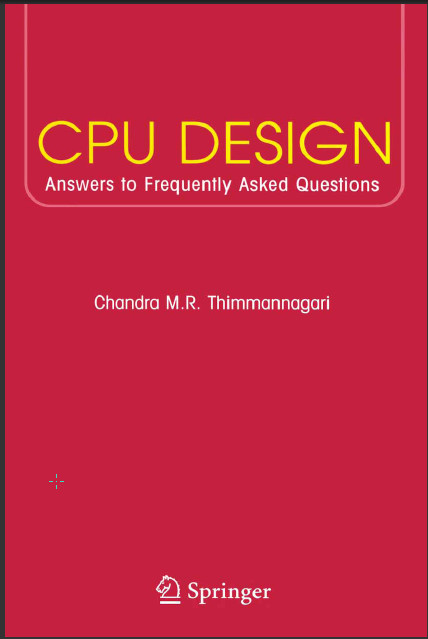資料介紹
I am honored to write the foreword for Chandra Thimmannagari’s book on CPU
design. Chandra’s book provides a practical overview of Microprocessor and high
end ASIC design as practiced today. It is a valuable addition to the literature on CPU
design, and is made possible by Chandra’s unique combination of extensive hands-on
CPU design experience at companies such as AMD and Sun Microsystems and a
passion for writing.
Technical books related to CPU design are almost always written by researchers in
academia or industry and tend to pick one area, CPU architecture/Bus architecture/
CMOS design that is the area of expertise of the author, and present that in great
detail. Such books are of great value to students and practitioners in that area.
However, engineers working on CPU design need to develop an understanding of
areas outside their own to be effective. CPU design is a multi dimensional problem
and one dimensional optimization is often counterproductive.
For instance, as someone who mainly does CPU architecture, I have found that CPU
architects who understand how logic design, circuit design and chip integration are
really done in practice do a much better job architecting the chip. There are
constraints in these different areas that could make an architectural idea hard to
implement, and an architect who understands these constraints is more likely to make
the right decisions upfront. However, there are really no books out there to help an
architect understand quickly how the later stages of chip design work. Reading
detailed technical books on physical design to obtain this knowledge is typically not
an option given time constraints. The most accessible way today to learn the broader
skill set necessary is from chatting with friends and picking up bits of knowledge
here and there. Over time the good ones do develop a working knowledge of all areas
of CPU design, but it takes many years.
The same goes for circuit designers who want to understand architecture. I have had
several circuit engineers come to me wanting to know more about architecture. I
answer questions as time permits and suggest they read “Hennessy and Patterson”. Ithelps, but goes only so far even though H&P is a really well written book. There is
just too much detail, and it is hard to filter out what is relevant.
In a way Chandra’s book is structured as a chat with a knowledgeable friend with
much time to spare. So we could imagine a circuit designer who is working on a
cache, and has a design problem - for instance, the replacement algorithm he is trying
to implement is not making timing. He will have to discuss this with the logic owner
or architect, but it will help if he has an understanding of the architectural options
available and any potential circuit issues with those options prior to the discussion.
He could look up this book and starting with the first question on caches (Q5 in
Architecture: What is cache memory in a CPU and what are the most common terms
associated with caches?) work through replacement policy related questions (Q10 to
Q15 in Architecture) to develop an understanding of the options available. Or
imagine an architect who is told that the particular idea she has in mind cannot be
implemented owing to routing density issues related to noise. She could look up the
relevant question in the book (Q6 in Circuits and Layout: What do you mean by
effect of noise in a design and what are the most common techniques used to reduce
its effect?) to develop a quick understanding of noise issues as well as possible
solutions and work with designers to find a way to implement her idea.
The book also provides excellent lists of techniques in the experienced logic/circuit
designer’s toolbox to attack a problem. For instance, a logic designer who is trying to
figure out how to make timing for a block could go straight to Q4 in the Logic
chapter and look at the list of suggestions there for fixing timing paths and start
making headway. Or a designer who is trying to reduce power for a block or a chip
could go to Q6 in the Logic chapter and look at the list of suggestions there for
reducing power. Or a circuit designer who is trying to fix noise problems could go to
Q6 in the Circuits and Layout chapter. Or a manager who wants to learn about design
tools available for a particular task could go to the relevant question in the Tools
chapter.
The book also includes good, concise descriptions of many thorny issues in CPU
design such as RAS, electromigration, IR drop, pass gate muxes and mintime fixes.
I believe the book will be a valuable addition to any CPU designer’s library.

- ADHV4702-1 Frequently Asked Questions (FAQs)
- AD7124-4 and AD7124-8 Frequently Asked Questions (FAQs)
- AD7606B Frequently Asked Questions (FAQs) (EngineerZone)
- Smoke Detection Solutions Frequently Asked Questions
- XAPP423 - PACE實現(xiàn)前的管腳布局創(chuàng)建 0次下載
- IR(國際整流器公司)功率半導體封裝介紹 0次下載
- Frequently Asked Questions N54
- Frequently Asked Questions B46
- Current Carrying Capacity of V 0次下載
- Verilog:常見的問題 0次下載
- verilog:Frequently Asked Quest 0次下載
- 制作一個精確的電流源(電流流出或吸收)
- 步進電機驅(qū)動器設計常見問題及解決方案的介紹(涉及器件L620
- NV SRAM Frequently Asked Quest
- ALLEGRO DESIGN WORKBENCH 0次下載
- 雙核cpu和單核cpu的區(qū)別 3511次閱讀
- 服務器cpu和普通電腦cpu的區(qū)別 6796次閱讀
- 什么是CPU使用率?如何測量CPU使用率? 6007次閱讀
- 西門子CPU-1200在線和診斷工具-比較離線CPU與在線CPU 4808次閱讀
- CPU為什么不做成圓形?CPU為什么是方形? 973次閱讀
- 介紹CPU超頻及作用與如何超頻及其好壞 9.4w次閱讀
- CPU為什么不做成圓形的? 1886次閱讀
- Linux:QEMU的CPU配置 5751次閱讀
- CPU到底是什么CPU的詳細資料講解 8365次閱讀
- CPU風扇的工作原理 1.5w次閱讀
- cpu超頻注意事項有哪些 淺談cpu超頻設置 1w次閱讀
- 手機cpu超頻免root方法_cpu超頻軟件推薦 10.1w次閱讀
- 手機cpu和電腦cpu的性能比較_影響CPU性能的因素盤點 2.1w次閱讀
- 手機cpu是什么_手機cpu介紹 2.2w次閱讀
- 晶圓如何變成cpu 2.1w次閱讀
下載排行
本周
- 1DC電源插座圖紙
- 0.67 MB | 2次下載 | 免費
- 2AN158 GD32VW553 Wi-Fi開發(fā)指南
- 1.51MB | 2次下載 | 免費
- 3AN148 GD32VW553射頻硬件開發(fā)指南
- 2.07MB | 1次下載 | 免費
- 4AN111-LTC3219用戶指南
- 84.32KB | 次下載 | 免費
- 5AN153-用于電源系統(tǒng)管理的Linduino
- 1.38MB | 次下載 | 免費
- 6AN-283: Σ-Δ型ADC和DAC[中文版]
- 677.86KB | 次下載 | 免費
- 7SM2018E 支持可控硅調(diào)光線性恒流控制芯片
- 402.24 KB | 次下載 | 免費
- 8AN-1308: 電流檢測放大器共模階躍響應
- 545.42KB | 次下載 | 免費
本月
- 1ADI高性能電源管理解決方案
- 2.43 MB | 450次下載 | 免費
- 2免費開源CC3D飛控資料(電路圖&PCB源文件、BOM、
- 5.67 MB | 138次下載 | 1 積分
- 3基于STM32單片機智能手環(huán)心率計步器體溫顯示設計
- 0.10 MB | 130次下載 | 免費
- 4使用單片機實現(xiàn)七人表決器的程序和仿真資料免費下載
- 2.96 MB | 44次下載 | 免費
- 53314A函數(shù)發(fā)生器維修手冊
- 16.30 MB | 31次下載 | 免費
- 6美的電磁爐維修手冊大全
- 1.56 MB | 24次下載 | 5 積分
- 7如何正確測試電源的紋波
- 0.36 MB | 17次下載 | 免費
- 8感應筆電路圖
- 0.06 MB | 10次下載 | 免費
總榜
- 1matlab軟件下載入口
- 未知 | 935121次下載 | 10 積分
- 2開源硬件-PMP21529.1-4 開關降壓/升壓雙向直流/直流轉(zhuǎn)換器 PCB layout 設計
- 1.48MB | 420062次下載 | 10 積分
- 3Altium DXP2002下載入口
- 未知 | 233088次下載 | 10 積分
- 4電路仿真軟件multisim 10.0免費下載
- 340992 | 191367次下載 | 10 積分
- 5十天學會AVR單片機與C語言視頻教程 下載
- 158M | 183335次下載 | 10 積分
- 6labview8.5下載
- 未知 | 81581次下載 | 10 積分
- 7Keil工具MDK-Arm免費下載
- 0.02 MB | 73810次下載 | 10 積分
- 8LabVIEW 8.6下載
- 未知 | 65988次下載 | 10 積分
 電子發(fā)燒友App
電子發(fā)燒友App

















 創(chuàng)作
創(chuàng)作 發(fā)文章
發(fā)文章 發(fā)帖
發(fā)帖  提問
提問  發(fā)資料
發(fā)資料 發(fā)視頻
發(fā)視頻 上傳資料賺積分
上傳資料賺積分









評論